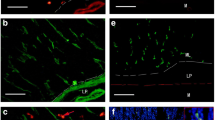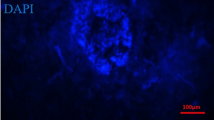Abstract
Manserin is a recently characterized 40-amino acid neuropeptide derived from secretogranin II, a protein belonging to the chromogranin family. Although the physiological roles of manserin have not been elucidated to date, manserin has been shown to distribute in not only the brain but also the endocrine system such as the pituitary and adrenal glands, suggesting its role in the endocrine system. The present study aimed to explore the occurrence and distribution of manserin in the rat pancreas using an immunohistochemical technique with a polyclonal antibody against rat manserin. Immunoreactivity for manserin was readily detected in almost whole islets of Langerhans whereas not at all in the exocrine pancreas. Manserin-expressing cells were not colocalized with the glucagon-secreting cells (α cells), whereas they colocalized with insulin-secreting cells (β cells) and somatostatin-secreting cells (δ cells), although their intracellular distribution was different. These results indicate that manserin, occurring in the endocrine pancreas, may have a potential role in the endocrine system.



Similar content being viewed by others
References
Anouar Y, Desmoucelles C, Yon L, Leprince J, Breault L, Gallo-Payet N, Vaudry H (1998) Identification of a novel secretogranin II-derived peptide (SgII(187–252)) in adult and fetal human adrenal glands using antibodies raised against the human recombinant peptide. J Clin Endocrinol Metab 83:2944–2951
Conlon JM (2009) Granin-derived peptides as diagnostic and prognostic markers for endocrine tumors. Regul Pept [Epub ahead of print]
Courel M, Vasquez MS, Hook VY, Mahata SK, Taupenot L (2008) Sorting of the neuroendocrine secretory protein Secretogranin II into the regulated secretory pathway: role of N- and C-terminal alpha-helical domains. J Biol Chem 283:11807–11822
Erspamer V, Melchiorri P, Erspamer CF, Negri L (1978) Polypeptides of the amphibian skin active on the gut and their mammalian counterparts. Adv Exp Med Biol 106:51–64
Fischer-Colbrie R, Laslop A, Kirchmair R (1995) Secretogranin II: molecular properties, regulation of biosynthesis and processing to the neuropeptide secretoneurin. Prog Neurobiol 46:49–70
Fischer-Colbrie R, Kirchmair R, Kahler CM, Wiedermann CJ, Saria A (2005) Secretoneurin: a new player in angiogenesis and chemotaxis linking nerves, blood vessels and immune system. Curr Protein Pept Sci 6:373–385
Helle KB (2009) Regulatory peptides from chromogranin A and secretogranin II: putative modulators of cells and tissues involved in inflammatory conditions. Regul Pept (in press)
Kamada N, Tano K, Oyabu A, Imura Y, Narita N, Tashiro Y, Uchida A, Komada Y, Narita M (2010) Immunohistochemical localization of manserin, a novel neuropeptide derived from secretogranin II, in rat adrenal gland, and its upregulation by physical stress. Int J Pept Res Ther 16:55–61
Leitner B, Fischer-Colbrie R, Scherzer G, Winkler H (1996) Secretogranin II: relative amounts and processing to secretoneurin in various rat tissues. J Neurochem 66:1312–1317
Marchese A, George SR, Kolakowski LFJ, Lynch KR, O’Dowd BF (1999) Novel GPCRs and their endogenous ligands: expanding the boundaries of physiology and pharmacology. Trends Pharmacol Sci 20:370–375
Montero-Hadjadje M, Pelletier G, Yon L, Li S, Guillemot J, Magoul R, Tillet Y, Vaudry H, Anouar Y (2003) Biochemical characterization and immunocytochemical localization of EM66, a novel peptide derived from secretogranin II in the rat pituitary and adrenal glands. J Histochem Cytochem 51:1083–1095
Portela-Gomes GM, Grimelius L, Stridsberg M (2008) Prohormone convertases 1/3, 2, furin and protein 7B2 (secretogranin V) in endocrine cells of the human pancreas. Regul Pept 146:117–124
Sakai Y, Hosaka M, Yoshinaga A, Hira Y, Harumi T, Watanabe T (2004) Immunocytochemical localization of secretogranin III in the endocrine pancreas of male rats. Arch Histol Cytol 67:57–64
Sakurai T, Amemiya A, Ishii M, Matsuzaki I, Chemelli RM, Tanaka H, Williams SC, Richardson JA, Kozlowski GP, Wilson S, Arch JR, Buckingham RE, Haynes AC, Carr SA, Annan RS, McNulty DE, Liu WS, Terrett JA, Elshourbagy NA, Bergsma DJ, Yanagisawa M (1998) Orexin and orexin receptors: a family of hypothalamic neuropeptides and G protein-coupled receptors that regulate feeding behavior. Cell 92:573–585
Schally AV, Arimira A, Baba Y, Nair RM, Matsuo H, Redding TW, Debeljuk L (1971) Isolations of properties of the FSH and LH-releasing hormone. Biochem Biophys Res Commun 43:393–399
Stridsberg M, Grimelius L, Portela-Gomes GM (2008) Immunohistochemical staining of human islet cells with region-specific antibodies against secretogranins II and III. J Anat 212:229–234
Takahashi T, Muneoka Y, Lohmann J, Lopes de Haro MS, Solleder G, Bosch TC, David CN, Bode HR, Koizumi O, Shimizu H, Hatta M, Fujisawa T, Sugiyama T (1997) Systemic isolation of peptide signal molecules regulating development in hydra: LW amide and PW families. Proc Natl Acad Sci USA 94:1241–1246
Tatemoto K, Mutt V (1980) Isolation of two novel candidate hormones using a chemical method for finding naturally occurring polypeptides. Nature 285:417–418
Taupenot L, Harper KL, O’Connor DT (2003) The chromogranin-secretogranin family. N Engl J Med 348:1134–1149
Trandaburu T, Syed Ali S, Trandaburu I (1999) Granin proteins (chromogranin A and secretogranin II C23-3 and C26-3) in the endocrine pancreas of reptiles. Ann Anat 181:489–494
Yajima A, Ikeda M, Miyazaki K, Maeshima T, Narita N, Narita M (2004) Manserin, a novel peptide from secretogranin II in the neuroendocrine system. Neuroreport 15:1755–1759
Yajima A, Narita N, Narita M (2008) Recently identified a novel neuropeptide manserin colocalize with the TUNEL-positive cells in the top villi of the rat duodenum. J Pept Sci 14:773–776
Zhao E, Basak A, Wong AOL, Ko W, Chen A, Lopez GC, Grey CL, Canosa LF, Somoza GM, Chang JP, Trudeau VL (2009a) The secretogranin II-derived peptide secretoneurin stimulates luteinizing hormone secretion from gonadotrophs. Neuroendocrinology 150:2273–2282
Zhao E, Zhang D, Basak A, Trudeau VL (2009b) New insights into granin-derived peptides: evolution and endocrine roles. Gen Comp Endocr 164:161–174
Author information
Authors and Affiliations
Corresponding author
Rights and permissions
About this article
Cite this article
Tano, K., Oyabu, A., Tashiro, Y. et al. Manserin, a secretogranin II-derived peptide, distributes in the rat endocrine pancreas colocalized with islet-cell specific manner. Histochem Cell Biol 134, 53–57 (2010). https://doi.org/10.1007/s00418-010-0709-7
Accepted:
Published:
Issue Date:
DOI: https://doi.org/10.1007/s00418-010-0709-7




